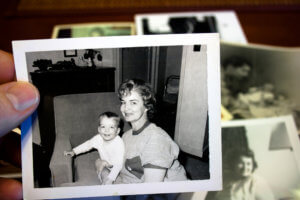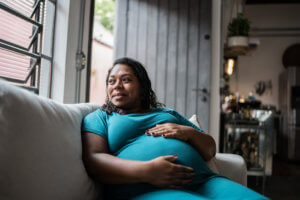In the Merriam-Webster dictionary, you will find the definition of adoption as: “to take by choice into a relationship; especially: to take voluntarily (a child of other parents) as one’s own child.”
This direct definition provides a glimpse into adoption, but does it fully answer what adoption is?
To truly define adoption, you have to look past the simplistic definition in the dictionary and think on a broader scale of what makes an adoption — for starters, everyone directly involved.
How Adoption Triad Members Define “Adoption”
Birth parents, adoptive families and adoptees will all have completely different answers to the question “What is the definition of adoption?”
While every individual’s definition of adoption will be different — and we don’t assume to speak for everyone — here’s what adoption means to some triad members.
How Birth Parents Define Adoption
For a birth mother, adoption is making a selfless decision to place her baby with another family. This decision is made out of love and to provide her child with the best life and opportunities which she cannot provide at the time.
Adoption provides the chance for a birth mother to achieve hopes and dreams that may not be possible if unexpectedly parenting. It allows birth mothers the ability to remain in their child’s life and create a brand-new support system, not only for her child, but also for herself.
How Adoptive Families Define Adoption
Adoptive parents will define adoption as the moment that made their lifelong dreams of becoming a family come true.
These families all have their own specific reasons for wanting to pursue adoption. Some may be struggling with infertility, and adoption is the only way available to grow their family. Others may realize the positive impact they can have on a child’s life through adoption. No matter the reason, the life-changing impact adoption provides them remains the same.
How Adoptees Define Adoption
When thinking about what the definition of adoption is, adoptees will reflect in different ways. Most will center their attention on the opportunities adoption has provided them, such as living in a safe and caring environment. Others who experience an open adoption will appreciate the support system they have grown up with and the ability of their birth and adoptive parents to discuss their situation openly and honestly.
These are just some of the ways that those who have been directly impacted by adoption may describe their personal definition of adoption.
For someone unfamiliar with the adoption process or the steps involved, it will be much more difficult to define adoption. However, when you choose to place your baby with another family, your adoption definition will be what you make of it — based on your needs, preferences and decisions along the way.
Adoption Definitions You Need to Know
If you’re a pregnant woman considering adoption, you are going to be faced with many questions and decisions. The adoption process and legal steps involved can be confusing, but trying to understand the different adoption definitions and terminologies can become a task in and of itself, as well.
Having a better grasp on these terms will help you understand adoption much more. It can also help give you a peace of mind as you consider this life-changing decision.
To help you navigate these different terms, we’ve compiled the following list of the most common adoption definitions and phrases. Although there are thousands of words, terms and phrases used in the adoption process, the following are most prevalent for pregnant women like you considering adoption.
Adoptee: The child that is being adopted.
Adoption: The legal process involved when birth parents’ parental rights are transferred to adoptive parents.
Adoption Agency: A licensed organization that helps facilitate the placement of children with adoptive families and provides birth parents the services needed to place their babies for adoption. These organizations act under the jurisdiction of state or licensing laws.
Adoption Attorney: Lawyers who specialize in adoption and make sure all steps are completed legally and ethically. All parties involved with an adoption will require an adoption attorney.
Adoption Consultant: Trained professional who helps prospective birth parents and adoptive families by facilitating the adoption.
Adoption Placement: Occurs after the birth parent has given consent and the adoption parents have received custody of the child.
Adoption Plan: The plan created between a prospective birth mother and a social worker, detailing all aspects of the adoption and the particular desires of the prospective birth mother.
Adoption Triad/Triangle: All parties directly involved in an adoption — the adoptee, adoptive parents and birth parents.
Adoptive Parent: The person(s) who obtains parental rights of a child during the adoption process.
Biological Child: The birth parents’ child.
Birth Father: The biological father of a child that is placed for adoption.
Birth Father Rights: The legal rights a prospective birth father has to allow or deny an adoption These rights will vary from state to state and in specific adoption situations.
Birth Mother: Biological mother of a child that is placed for adoption.
Birth Parent: The biological parents of a child placed for adoption.
Closed Adoption: Adoption in which the identities of the birth parents and adoptive family remain confidential. The courts typically seal all records, and o communication occurs between the two sides post-placement.
Confidentiality: Keeping identifying or other significant information private. Legal and ethical practice which requires social workers and other professionals not to disclose information without the consent of their client.
Consent Form: The legal document signed by the birth parents, which allows their child to be placed for adoption and relinquishes their parental rights.
Domestic Infant Adoption: When a newborn is placed for adoption in the United States.
Extended Birth Family: A child’s biological relatives such as aunts, uncles and grandparents.
Finalization: Court approval of the adoption, awarding permanent legal custody of a child to the adoptive parents.
Foster Care: Temporary custodial care for a child whose biological parents cannot provide proper care. Some foster care situations turn into a permanent, foster care adoption.
Foster- Care Adoption: A child placement in which birth parents’ rights have not yet been terminated by the court; or in which birth parents are appealing the court’s decision but foster parents agree to adopt the child if/when parental rights are terminated. Social workers place the child with specially trained foster parents who will work toward family reunification efforts but who will adopt the child if the child becomes eligible for adoption. The main reason for making such a placement, also called legal-risk adoption, is to spare the child another move.
Foster Child: A child who is placed under foster care or in a group care facility because their biological parents cannot temporarily or permanently provide care.
Foster Parent: Adult who takes care of foster children. This adult is state-licensed to be a foster parent and is not typically a blood relative to the children.
Grief: A feeling of emotional sadness or loss. Grief is common among members of the adoption triad during portions of the adoption process
Identifying Information: Information which discloses identities of birth parents or adoptive families.
International Adoption: When a child is adopted from a country outside of the United States
Legal Custody: Guardians responsibility for a person, assigned to them according to law.
Legal Guardian: Person appointed to make the legal decisions for a child.
Life Book: A book which provides a representation of the child’s life, designed to help the child make sense of their unique background. This book will often include information of their birth, such as location and date, birth parents, family history and more. Social workers, foster parents or adoptive parents generally create this book.
Loss: A feeling of emotional deprivation that is often experienced at some point in time throughout the adoption process. The intensity will vary in each specific adoption situation. Birth parents usually feel the strongest emotion of loss during or after placement of their child. Adoptive parents may feel loss during infertility and the inability to bear a child. Adoptees may feel loss at different stages of their adoption, due to the loss of their birth parents and family.
Non-Identifying Information: Information exchanged between the birth parents and adoptive families, such as medical history or background information, which does not include any personal identifiable information.
Open Adoption: An adoption where birth parents and adoptive parents share personal, identifiable information. Communication may continue after placement, as well as updates for birth parents on their child and, in some situations, in-person meetings between the adoption triad members.
Private Adoption Agencies: State-licensed agencies, with no government affiliations, that provide adoption services and primarily deal with domestic infant adoptions.
Public Adoption Agencies: Governmental adoption agency or social service which provides adoption services. Generally deals with children in foster care.
Relinquishment: When birth parents legally consent to an adoption and give up all legal parental rights so their child can be adopted.
Reunification: The act of returning a foster child to the custody of their parent(s) after a period of foster care.
Reunion: A meeting between birth parent(s) and an adopted adult or between an adopted adult and other birth relatives. Typically occurs when the adopted adult was placed as an infant in a closed adoption.
Revoke: When a birth parent takes back their consent to an adoption. This option will vary from state to state, as some laws offer no opportunity for revocation and others allow a specific time period.
Search: An attempt from an adoptee or birth parent to find information on their birth parents or their child.
Semi-Open Adoption: Adoption where adoptive family and birth parents may talk, meet and have correspondence after the adoption, but no identifying information is exchanged.
Semi-Open Adoption: Adoption in which the birth parents and adoptive parents often exchange non-identifying information prior to placement. After the child is placed in the adoptive home, the birth family may receive updates in the form of letters, pictures or other communications sent through the mediation of the adoption agency or attorney who assisted in the placement.
Social Worker: Trained and licensed professional who works with prospective birth parents and adoptive families during adoption.
Stepparent Adoption: The adoption of a child by the new spouse of the birth parent.
Surrender: The voluntary termination of parental rights.
Surrender Papers: Legal document confirming the birth parent’s voluntary relinquishment of parental rights.
Termination of Parental Rights: The legal process which involuntarily terminates biological parents’ parental rights to their child.
Voluntary Adoption Registry: A registry system which increases the chances of adoptees’, birth parents’ and biological siblings’ ability to locate each other by using the voluntary list of adoptees and birth relatives.
Waiting Period: The legally determined time period that must occur between birth of the child and the birth parents consent to the adoption. This will vary state by state.
These terms will all help you define adoption as a prospective birth mother. Truly understanding what the definition of adoption is provides the insight you may need to determine if adoption is right for you.
If you need clarification of any of the terms or steps, contact us anytime, obligation-free. You’ll be referred to an adoption specialist who can provide you with any further information or resources you may need.









